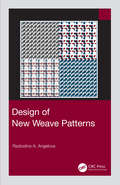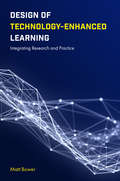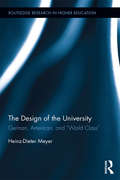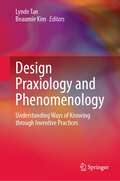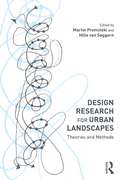- Table View
- List View
The Design of Learning Experience: Creating the Future of Educational Technology (Educational Communications and Technology: Issues and Innovations)
by Brad Hokanson Gregory Clinton Monica W. TraceyThis book delves into two divergent, yet parallel themes; first is an examination of how educators can design the experiences of learning, with a focus on the learner and the end results of education; and second, how educators learn to design educational products, processes and experiences. The book seeks to understand how to design how learning occurs, both in the instructional design studio and as learning occurs throughout the world. This will change the area's semantics; at a deeper level, it will change its orientation from instructors and information to learners; and it will change how educators take advantage of new and old technologies. This book is the result of a research symposium sponsored by the Association for Educational Communications and Technology [AECT].
The Design of Learning Spaces (Future Schools)
by Pamela WoolnerLearning can take place anywhere. So does the detail of the physical surroundings provided by schools matter? After many years of minimal investment in school premises, schools in the UK are in the midst of a wave of planning, building and using new schools. This includes all English secondary schools, being renewed through Building Schools for the Future (BSF), as well as schemes for English primaries and programmes of school construction in Scotland and Wales. Starting from an educational perspective, and building on work in architectural design, Pamela Woolner gives an overview of current issues in the design of learning environments, covering the physical design of spaces and how that design impacts on the organisation of people in schools, their relationships and their teaching and learning. Filling the gap in understanding and knowledge between the worlds of architecture and education, this is essential reading for school leaders and all those engaged in thinking about how school design might be planned and arranged to facilitate learning and teaching.
The Design of Learning Spaces (Future Schools)
by Pamela WoolnerLearning can take place anywhere. So does the detail of the physical surroundings provided by schools matter? After many years of minimal investment in school premises, schools in the UK are in the midst of a wave of planning, building and using new schools. This includes all English secondary schools, being renewed through Building Schools for the Future (BSF), as well as schemes for English primaries and programmes of school construction in Scotland and Wales. Starting from an educational perspective, and building on work in architectural design, Pamela Woolner gives an overview of current issues in the design of learning environments, covering the physical design of spaces and how that design impacts on the organisation of people in schools, their relationships and their teaching and learning. Filling the gap in understanding and knowledge between the worlds of architecture and education, this is essential reading for school leaders and all those engaged in thinking about how school design might be planned and arranged to facilitate learning and teaching.
Design of New Weave Patterns
by Radostina A. AngelovaThis book presents a systematic study on methods used for the creation of weave patterns for simple structures. Firstly, it explains known techniques for designing new weave patterns classified as patterns merge, motifs, patterns insertion and change of the displacement number. These are discussed as possibilities to create different textures and weaving effects supported by figures of patterns, colour view, and fabric appearance simulation. Secondly, it explains original methods for design of new weave patterns based on Boolean operations, musical scores, written texts and braille alphabet, including transformations performed, advantages/disadvantages, possible applications and designs.
Design of New Weave Patterns
by Radostina A. AngelovaThis book presents a systematic study on methods used for the creation of weave patterns for simple structures. Firstly, it explains known techniques for designing new weave patterns classified as patterns merge, motifs, patterns insertion and change of the displacement number. These are discussed as possibilities to create different textures and weaving effects supported by figures of patterns, colour view, and fabric appearance simulation. Secondly, it explains original methods for design of new weave patterns based on Boolean operations, musical scores, written texts and braille alphabet, including transformations performed, advantages/disadvantages, possible applications and designs.
Design of Technology-Enhanced Learning: Integrating Research and Practice
by Matt BowerEducators and researchers worldwide are confronted by a tantalizing challenge – how should contemporary technologies be used to enhance learning? This book provides a broad academic and teaching audience with an integrated understanding of learning technology research, and how it can be used to enhance the design of learning environments. Whereas some books focus exclusively on research relating to learning technology and others propose ways to use technology effectively, this book synthesises research for the purpose of informing best practice. After laying pedagogical, technological and content foundations, it examines research relating to the educational use of Web 2.0, social networking, mobile devices and virtual worlds. Analysis across these contexts leaves readers with a nuanced understanding of how technology-enhanced learning design principles may (or may not) be abstracted across different learning technology environments. Providing an integrated portrayal of learning technology research enables educators (academics, school teachers, pre-service teachers and educational designers) to immediately adopt evidence-based approaches in their teaching. The comprehensive synthesis of the literature also helps learning technology researchers to more clearly identify the interrelationships between different areas of learning technology research, as well as position their work amongst the practical problems of the field. Rich with examples, this book is suitable for those who want to adopt a design-based and research-driven approach to enhancing learning using technology.
Design of Technology-Enhanced Learning: Integrating Research and Practice
by Matt BowerEducators and researchers worldwide are confronted by a tantalizing challenge – how should contemporary technologies be used to enhance learning? This book provides a broad academic and teaching audience with an integrated understanding of learning technology research, and how it can be used to enhance the design of learning environments. Whereas some books focus exclusively on research relating to learning technology and others propose ways to use technology effectively, this book synthesises research for the purpose of informing best practice. After laying pedagogical, technological and content foundations, it examines research relating to the educational use of Web 2.0, social networking, mobile devices and virtual worlds. Analysis across these contexts leaves readers with a nuanced understanding of how technology-enhanced learning design principles may (or may not) be abstracted across different learning technology environments. Providing an integrated portrayal of learning technology research enables educators (academics, school teachers, pre-service teachers and educational designers) to immediately adopt evidence-based approaches in their teaching. The comprehensive synthesis of the literature also helps learning technology researchers to more clearly identify the interrelationships between different areas of learning technology research, as well as position their work amongst the practical problems of the field. Rich with examples, this book is suitable for those who want to adopt a design-based and research-driven approach to enhancing learning using technology.
The Design of the University: German, American, and “World Class” (Routledge Research in Higher Education)
by Heinz-Dieter MeyerWhat is the reason for the American university’s global preeminence? How did the American university succeed where the development of the German university, from which it took so much, stalled? In this closely-argued book, Meyer suggests that the key to the American university’s success is its institutional design of self-government. Where other university systems are dependent on the patronage of state, church, or market, the American university is the first to achieve true autonomy, which it attained through an intricate system of engagements with societal actors and institutions that simultaneously act as amplifiers of its impact and as checks on the university’s ever-present corrosive tendencies. Built on a searching analysis of the design thinking of Wilhelm von Humboldt and Adam Smith and closely tracing the learning process by which Americans adapted the German model, The Design of the University dismisses efforts to copy superficial features of the American university in order to achieve world-class rank. Calling attention to the design details of the university and the particulars of its institutional environment, this volume identifies the practices and choices that produced the gold standard for today’s world class higher education.
The Design of the University: German, American, and “World Class” (Routledge Research in Higher Education #26)
by Heinz-Dieter MeyerWhat is the reason for the American university’s global preeminence? How did the American university succeed where the development of the German university, from which it took so much, stalled? In this closely-argued book, Meyer suggests that the key to the American university’s success is its institutional design of self-government. Where other university systems are dependent on the patronage of state, church, or market, the American university is the first to achieve true autonomy, which it attained through an intricate system of engagements with societal actors and institutions that simultaneously act as amplifiers of its impact and as checks on the university’s ever-present corrosive tendencies. Built on a searching analysis of the design thinking of Wilhelm von Humboldt and Adam Smith and closely tracing the learning process by which Americans adapted the German model, The Design of the University dismisses efforts to copy superficial features of the American university in order to achieve world-class rank. Calling attention to the design details of the university and the particulars of its institutional environment, this volume identifies the practices and choices that produced the gold standard for today’s world class higher education.
Design Pedagogy: Developments in Art and Design Education
by Mike ToveyDesign Pedagogy explains why it is vital for design students that their education helps them construct a ’passport’ to enter the professional sphere. Recent research into design teaching has focused on its signature pedagogies, those elements which are particularly characteristic of the disciplines. Typically based on core design theory, enlivened by approaches imported to the area, such work has utility when it recognizes the visual language of designing, the media of representation used, and the practical realities of tackling design questions. Increasingly the 21st century sees these activities in a global context where the international language of the visual artefact is recognized. This book draws on recent work in these areas. It includes a number of chapters which are developed from work undertaken during the period of special funding for centres of teaching excellence in the UK up until 2010. Two of those in design have provided the basis for research and innovative developments reported on here. They have helped to enliven the environment for design pedagogy research in other establishments which are also included. Design students need support for the agile navigation through the design process. Learning experiences should develop students’ natural motivations and professionalise motivation to create a resilient, informed and sustainable capacity. This is the essence of ’transformative learning’. This collection explores how design education is, in itself, a passport to practice and showcases how some of the key developments in education use techniques related to collaboration, case studies and experience to motivate students, enable them to express their identity, reflect and learn.
Design Pedagogy: Developments in Art and Design Education
by Mike ToveyDesign Pedagogy explains why it is vital for design students that their education helps them construct a ’passport’ to enter the professional sphere. Recent research into design teaching has focused on its signature pedagogies, those elements which are particularly characteristic of the disciplines. Typically based on core design theory, enlivened by approaches imported to the area, such work has utility when it recognizes the visual language of designing, the media of representation used, and the practical realities of tackling design questions. Increasingly the 21st century sees these activities in a global context where the international language of the visual artefact is recognized. This book draws on recent work in these areas. It includes a number of chapters which are developed from work undertaken during the period of special funding for centres of teaching excellence in the UK up until 2010. Two of those in design have provided the basis for research and innovative developments reported on here. They have helped to enliven the environment for design pedagogy research in other establishments which are also included. Design students need support for the agile navigation through the design process. Learning experiences should develop students’ natural motivations and professionalise motivation to create a resilient, informed and sustainable capacity. This is the essence of ’transformative learning’. This collection explores how design education is, in itself, a passport to practice and showcases how some of the key developments in education use techniques related to collaboration, case studies and experience to motivate students, enable them to express their identity, reflect and learn.
Design Praxiology and Phenomenology: Understanding Ways of Knowing through Inventive Practices
by Lynde Tan Beaumie KimThis book offers insight into designerly ways of knowing from the perspectives of experts and professionals engaging in diverse forms of design in workplaces and other public domains. It also aids in the understanding of design practices from designers’ viewpoints via case studies. By pursuing a reflective inquiry in their design epistemology (designerly ways of knowing), design praxiology (practices of design), or design phenomenology (forms of designs), self-studies of design practices, and presenting studies of designs, the authors of this book demonstrate how they influence the people and the object of inquiry or design. The case studies presented in this book also illustrate how designers develop their expertise, and provides inspiration for the incorporation of design-thinking and practice in education.
Design Principles for Photography
by Jeremy WebbIn an age over-saturated with photographic imagery, Design Principles for Photography demonstrates how design awareness can add a new level of depth to your images. By adapting and experimenting with the tried and tested techniques used by graphic designers every day, you can add dynamism and impact to your imagery, whatever the style or genre - something that today's editors, curators and publishers are all crying out for.The second edition includes examples of unsuccessful compositions, annotated images highlighting key techniques and an expanded glossary. There’s also a new section on movements in photography and their reflection in composition, including modernism, expressionism, and surrealism and interviews with international practitioners discussing how they’ve included design principles in their work. Featured topics: Basic design theory; the use of space; positional decisions; the elements of design; line; shape or form; space; texture; light; colour; pattern; rhythm; contrast; scale and proportion; abstraction; movement and flow; containment; emphasis and emotion; justaposition; incongruity; mood and emotion.
Design Principles for Photography
by Jeremy WebbIn an age over-saturated with photographic imagery, Design Principles for Photography demonstrates how design awareness can add a new level of depth to your images. By adapting and experimenting with the tried and tested techniques used by graphic designers every day, you can add dynamism and impact to your imagery, whatever the style or genre - something that today's editors, curators and publishers are all crying out for.The second edition includes examples of unsuccessful compositions, annotated images highlighting key techniques and an expanded glossary. There’s also a new section on movements in photography and their reflection in composition, including modernism, expressionism, and surrealism and interviews with international practitioners discussing how they’ve included design principles in their work. Featured topics: Basic design theory; the use of space; positional decisions; the elements of design; line; shape or form; space; texture; light; colour; pattern; rhythm; contrast; scale and proportion; abstraction; movement and flow; containment; emphasis and emotion; justaposition; incongruity; mood and emotion.
Design Realities: Creativity, Nature and the Human Spirit
by Stuart WalkerDesign Realities explores a wide range of topics on creativity, design and spiritual well-being. Using critique, rational inquiry and personal reflection, Stuart Walker looks squarely at our contemporary condition, demonstrates how current assumptions and material expectations are becoming untenable and, most importantly, offers constructive new directions that are feasible, spiritually enriching, and hopeful. Comprising short essays, lyrical pieces, photo studies and longer discourses, this book takes us on a highly readable and enjoyable journey through some of the most pressing issues of our time. The innovative, intuitive format makes these topics readily accessible, while providing much food for thought about the changing nature of creativity in today’s world. Written by a leading thinker in the field, this highly original book offers readers something to ponder, discuss, contest and build upon.
Design Realities: Creativity, Nature and the Human Spirit
by Stuart WalkerDesign Realities explores a wide range of topics on creativity, design and spiritual well-being. Using critique, rational inquiry and personal reflection, Stuart Walker looks squarely at our contemporary condition, demonstrates how current assumptions and material expectations are becoming untenable and, most importantly, offers constructive new directions that are feasible, spiritually enriching, and hopeful. Comprising short essays, lyrical pieces, photo studies and longer discourses, this book takes us on a highly readable and enjoyable journey through some of the most pressing issues of our time. The innovative, intuitive format makes these topics readily accessible, while providing much food for thought about the changing nature of creativity in today’s world. Written by a leading thinker in the field, this highly original book offers readers something to ponder, discuss, contest and build upon.
Design Research for Urban Landscapes: Theories and Methods
by Martin Prominski Hille SeggernWithin the spatial design disciplines, research through design as a tool and practice has often been neglected. This book provides a much-needed companion to the theories, methods and processes involved in using design-based research in landscape, architecture and urban design. Aimed specifically at researchers completing PhD projects, supervisors and designers working in practice, it covers applied approaches to help you to use design research in your work. With fully illustrated examples of original international design research PhDs from a variety of programme types, such as individual, structured and practice-based, Design Research for Urban Landscapes offers PhD candidates and supervisors a clear foundational pathway.
Design Research for Urban Landscapes: Theories and Methods
by Martin Prominski Hille SeggernWithin the spatial design disciplines, research through design as a tool and practice has often been neglected. This book provides a much-needed companion to the theories, methods and processes involved in using design-based research in landscape, architecture and urban design. Aimed specifically at researchers completing PhD projects, supervisors and designers working in practice, it covers applied approaches to help you to use design research in your work. With fully illustrated examples of original international design research PhDs from a variety of programme types, such as individual, structured and practice-based, Design Research for Urban Landscapes offers PhD candidates and supervisors a clear foundational pathway.
Design Research in Education: A Practical Guide for Early Career Researchers
by Arthur BakkerDesign Research in Education is a practical guide containing all the information required to begin a design research project. Providing an accessible background to the methodological approaches used in design research as well as addressing all the potential issues that early career researchers will encounter, the book uniquely helps the early career researcher to gain a full overview of design research and the practical skills needed to get their project off the ground. Based on extensive experience, the book also contains multiple examples of design research from both undergraduate and postgraduate students, to demonstrate possible projects to the reader. With easy to follow chapters and accessible question and response sections, Design Research in Education contains practical advice on a wide range of topics related to design research projects including: The theory of design research, what it entails, and when it is suitable The formulation of research questions How to structure a research project The quality of research and the methodological issues of validity and reliability How to write up your research The supervision of design research. Through its theoretical grounding and practical advice, Design Research in Education is the ideal introduction into the field of design based research and is essential reading for bachelor's, master's and PhD students new to the field, as well as to supervisors overseeing projects that use design research.
Design Research in Education: A Practical Guide for Early Career Researchers
by Arthur BakkerDesign Research in Education is a practical guide containing all the information required to begin a design research project. Providing an accessible background to the methodological approaches used in design research as well as addressing all the potential issues that early career researchers will encounter, the book uniquely helps the early career researcher to gain a full overview of design research and the practical skills needed to get their project off the ground. Based on extensive experience, the book also contains multiple examples of design research from both undergraduate and postgraduate students, to demonstrate possible projects to the reader. With easy to follow chapters and accessible question and response sections, Design Research in Education contains practical advice on a wide range of topics related to design research projects including: The theory of design research, what it entails, and when it is suitable The formulation of research questions How to structure a research project The quality of research and the methodological issues of validity and reliability How to write up your research The supervision of design research. Through its theoretical grounding and practical advice, Design Research in Education is the ideal introduction into the field of design based research and is essential reading for bachelor's, master's and PhD students new to the field, as well as to supervisors overseeing projects that use design research.
Design Research in Social Studies Education: Critical Lessons from an Emerging Field
by Beth C. Rubin Eric B Freedman Jongsung KimThis edited volume showcases work from the emerging field of design-based research (DBR) within social studies education and explores the unique challenges and opportunities that arise when applying the approach in classrooms. Usually associated with STEM fields, DBR’s unique ability to generate practical theories of learning and to engineer theory-driven improvements to practice holds meaningful potential for the social studies. Each chapter describes a different DBR study, exploring the affordances and dilemmas of the approach. Chapters cover such topics as iterative design, using and producing theory, collaborating with educators, and the ways that DBR attends to historical, political, and social context.
Design Research in Social Studies Education: Critical Lessons from an Emerging Field
by Beth C. Rubin Eric B Freedman Jongsung KimThis edited volume showcases work from the emerging field of design-based research (DBR) within social studies education and explores the unique challenges and opportunities that arise when applying the approach in classrooms. Usually associated with STEM fields, DBR’s unique ability to generate practical theories of learning and to engineer theory-driven improvements to practice holds meaningful potential for the social studies. Each chapter describes a different DBR study, exploring the affordances and dilemmas of the approach. Chapters cover such topics as iterative design, using and producing theory, collaborating with educators, and the ways that DBR attends to historical, political, and social context.
Design Research on Learning and Thinking in Educational Settings: Enhancing Intellectual Growth and Functioning (Educational Psychology Series)
by David Yun DaiThe key question this book addresses is how to identify and create optimal conditions for the kind of learning and development that is especially important for effectively functioning in the 21st century. Taking a new approach to this long-debated issue, it looks at how a design research-based science of learning (with its practical models and related design research) can provide insights and integrated models of how human beings actually function and grow in the social dynamics of educational settings with all their affordances and constraints. More specifically: How can specific domains or subject matters be taught for broad intellectual development? How can technology be integrated in enhancing human functioning? How can the social organization of classroom learning be optimized to create social norms for promoting deep intellectual engagement and personal growth? Part I is concerned with broad conceptual and technical issues regarding cultivating intellectual potential, with a focus on how design research might fill in an important a niche in addressing these issues. Part II presents specific design work in terms of design principles, models, and prototypes.
Design Research on Learning and Thinking in Educational Settings: Enhancing Intellectual Growth and Functioning (Educational Psychology Series)
by David Yun DaiThe key question this book addresses is how to identify and create optimal conditions for the kind of learning and development that is especially important for effectively functioning in the 21st century. Taking a new approach to this long-debated issue, it looks at how a design research-based science of learning (with its practical models and related design research) can provide insights and integrated models of how human beings actually function and grow in the social dynamics of educational settings with all their affordances and constraints. More specifically: How can specific domains or subject matters be taught for broad intellectual development? How can technology be integrated in enhancing human functioning? How can the social organization of classroom learning be optimized to create social norms for promoting deep intellectual engagement and personal growth? Part I is concerned with broad conceptual and technical issues regarding cultivating intellectual potential, with a focus on how design research might fill in an important a niche in addressing these issues. Part II presents specific design work in terms of design principles, models, and prototypes.
Design Science and Its Importance in the German Mathematics Educational Discussion (ICME-13 Topical Surveys)
by Marcus Nührenbörger Bettina Rösken-Winter Chun Ip Fung Ralph Schwarzkopf Erich Christian Wittmann Kathrin Akinwunmi Felix Lensing Florian SchachtThis ICME-13 Topical Survey reviews the state-of-the-art by first exploring the roots and scope of design science. Second, it presents two examples of current design science projects that focus on substantial learning environments including a student and a teacher perspective. Subsequently, the book elaborates on how empirical research can be conceptualised within design science. Lastly, it explores developments in design science from a national and international perspective, while also discussing current trends in design research. Within the German-language tradition, considering ‘mathematics education as a design science’ primarily draws on the works of Wittmann. The core of this approach constitutes designing and investigating learning environments that involve substantial mathematics.


